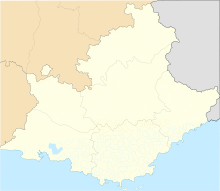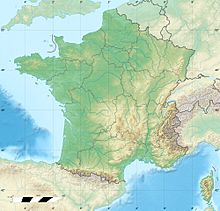Grotte du Vallonnet facts for kids
|
Grotte du Vallonnet
|
|
| Alternative name | Vallonnet cave |
|---|---|
| Location | near Roquebrune-Cap-Martin, between Monaco and Menton |
| Region | Alpes-Maritimes Department, France |
| Coordinates | 43°45′51″N 7°28′11″E / 43.76417°N 7.46972°E |
| Site notes | |
| Excavation dates | 1962 |
The Grotte du Vallonnet is an amazing archaeological site. It is located near Roquebrune-Cap-Martin, between Monaco and Menton, in France. This cave was first found in 1958. Stone tools found here are about 1 to 1.05 million years old. This makes it one of the oldest places where humans lived in Europe!
Contents
What is the Grotte du Vallonnet like?
The Vallonnet cave is on the side of Cap Martin. It is about 110 meters (360 feet) above the Bay of Menton. The cave opens into a small valley with a creek. This creek flows down to the bay.
The entrance to the cave is narrow and low. It leads to a corridor about 5 meters (16 feet) long. After the corridor, there is a room about 4 meters (13 feet) high.
How was the Grotte du Vallonnet discovered?
A 13-year-old girl named Marianne Poire discovered the cave in 1958. She often visited the cave to collect pieces of calcite. One day, she showed her finds to René Pascal. He was an amateur prehistorian, meaning he loved studying ancient times.
Marianne then led her parents, Pascal, and others to the cave entrance. The first official digs started in 1962.
What did archaeologists find in the cave?
Archaeologists found five different layers of dirt and rock in the cave. Each layer tells us something about the past.
- Layer I: This was a floor made of stalagmites. It is about 1.37 to 1.4 million years old. Pollen in this layer showed that the area was a forest.
- Layer II: This layer had beach sand, seashells, and fish bones. It is a little over 1.05 million years old. The fish bones suggest that a warm, tropical sea once reached the cave. The climate was warm with mild winters.
- Layer III: This was the thickest layer, about 1.5 meters (5 feet) deep. It had sand mixed with stones and rocks. Many animal bones were found here. These bones were brought by humans or by meat-eating animals. The climate was drier at this time. This layer is very important because it helped scientists date the cave. It is between 1.05 and 1 million years old.
- Layer IV: About one million years ago, the cave entrance was washed away. A thick stalagmite floor formed over the remaining dirt. This layer is about 890,000 to 900,000 years old. The climate was cooler and wetter than today.
- Layer V: This top layer has different sands from earlier layers. It was formed during wet periods that came later.
What animals lived near the cave?
Layer III had the most exciting finds. It contained many animal bones and 11 simple tools made by humans. It seems that large meat-eating animals used the cave as a dining spot. These included bears, panthers, saber-tooth tigers, and large hyenas. They brought the bodies of plant-eating animals to the cave. These animals included deer, bison, rhinoceros, horses, and boars.
When the predators were not in the cave, humans used it. They left their tools behind.
Scientists found bones from 25 different types of mammals in the cave. All of them lived during the early Pleistocene age. Some animals found were the Eurasian jaguar, the leopard, and the meridional elephant. Later, bones of an early wolf, an early fox, and a cave lynx were also found.
What tools did early humans use?
About 100 basic tools made by humans were found in the cave. Most were made of limestone, and some were made of sandstone. A few tools were made of quartz and flint. Many were pounding tools, used for hitting things. These tools were simple and not very well made. One bison leg bone even showed signs of being used as a pounding tool.
Most animal bones in the cave were broken by the teeth of predators. However, some bones had marks showing they were broken by these early tools. It seems the early humans at Vallonnet cave used their stone tools to break bones. They likely did this to eat the marrow inside.
There was no sign of fire in the cave. This means fire was probably not yet used by humans. It seems the people who visited the cave were not hunters. Instead, they were scavengers. This means they ate meat from animals that predators had already killed. There were also no signs that humans lived in the cave. They likely just visited it.
How does Grotte du Vallonnet compare to other ancient sites?
The Grotte du Vallonnet is one of the oldest sites in Europe. Here's how it compares to other important archaeological sites:
- Gona, Ethiopia: The oldest known human-made stone tools, about 2.55 million years old.
- Dmanisi, Georgia: Remains of Homo georgicus, the oldest human fossils in Europe, about 1.8 million years old.
- Barranco Leon, Fuenta Nueva Three, Sima del Elefante, Atapuerca, Spain: About 1.1 to 1.2 million years old.
- Grotte du Vallonnet: About 1 to 1.05 million years old.
- Gran Dolina, Atapuerca, Spain: About 780,000 years old.
- Terra Amata, Nice, France: About 480,000 years old.
- Lascaux Caves, Dordogne, France: Famous cave paintings, about 17,300 years old.



